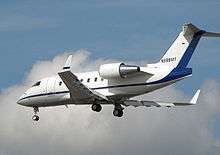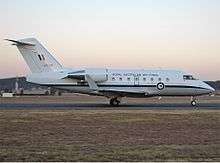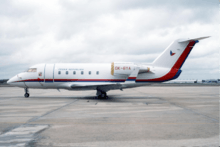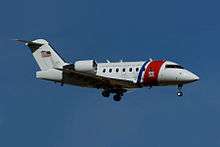Bombardier Challenger 600 series
| Challenger 600/601/604/605/650 | |
|---|---|
.jpg) | |
| Role | Business jet |
| Manufacturer | Bombardier Aerospace |
| First flight | 8 November 1978 |
| Status | Active In production |
| Produced | 1978–present |
| Number built | 1000 (as of Nov 2015)[1] |
| Unit cost | |
| Developed into | CRJ-100/200 |
The Bombardier Challenger 600 series is a family of business jets. It was first produced by Canadair as an independent company and then produced from 1986 by Canadair as a division of Bombardier Aerospace.
Development

The origin of the Challenger 600 lies in Canadair’s purchase of a concept for a business jet aircraft, the LearStar 600 from the American inventor and aircraft developer Bill Lear. However, Lear had practically no influence on the ensuing development and design of the aircraft.[3][4] Even the name LearStar was not new to this concept, since Lear had long before used the name for his conversion of Lockheed Lodestars into business transports.[5] Thus, Canadair quickly abandoned the name LearStar and adopted the name Challenger.[6]
Canadair's top management was of the opinion that Lear’s concept was sketchy at best.[4] Lear did not have an expert grasp of aeronautical engineering.[7] He was also at a financial low point, with a skeleton staff. Thus, he had only been able to pay a California aeronautical consultant to do some very preliminary design explorations.[8]
However, Canadair planned to use Lear’s name and skills at self-promotion to secure extensive financial guarantees for a business jet project from the Canadian Federal government.[4] This proved an effective choice. In Challenger: An Industrial Romance , the 1980 The National Film Board of Canada documentary on the development of the aircraft, future Prime Minister Jean Chrétien specifically refers to the effect of personal contact with Lear (on Chrétien’s decision to direct financial support to Canadair’s program).[9]
At the time of these events, Chrétien was successively President of the Treasury Board, Minister of Industry, Trade and Commerce, and Minister of Finance, in the Canadian Federal government. Due to the use of letters of comfort, the extent of the Ministry's financial commitments for Canadair could be kept from parliament and the public for several years.[10] These financial guarantees were later used as an academic example of insufficient monitoring and lax controls in government support of industry.[11]
While the Challenger would be similar in general configuration to other aircraft of its type already on the market, certain of its features would stand out, for example, the use of a widened fuselage that allowed a "walk-about cabin". The Challenger was also one of the first bizjets designed with a supercritical wing.
On 8 November 1978, the prototype aircraft took off at Montreal, Quebec, Canada. The second and third prototypes flew in 1979. A test flight on 3 April 1980 in the Mojave Desert resulted in disaster, the aircraft crashing due to the failure of the release mechanism to detach the recovery chute after a deep stall, killing one of the test pilots (the other test pilot and the flight test engineer parachuted to safety).[12]
Despite the crash, both Transport Canada and the Federal Aviation Administration in the United States certified the aircraft in 1980, albeit with restrictions to pilots including a limited maximum takeoff weight. A program to reduce the aircraft's weight was then implemented to improve the aircraft's range.
Challengers can be identified visually by their distinctive double slotted hinged flap design, where the fairings can be seen below the wings, a sight much more common on commercial airliners.
Variants


CL-600
- CL-600
- Original production version, powered by Avco Lycoming ALF 502L turbofans of 7500 lbf (33.6 kN) thrust each. Built from 1978 to 1982 (81 built)
- CL-600S
- Three CL-600s retrofitted with the winglets introduced on the CL-601-1A.
- Canadair CC-144
- 12 aircraft purchased by the Royal Canadian Air Force, including the CE-144 and CX-144
- Canadair CE-144
- Three Electronic warfare / EW trainers converted to/from basic CC-144.
- Canadair CX-144
- Second prototype, a CL-600-1A11, c/n 1002, allocated to the RCAF after finishing test programme. Used at the Aerospace Engineering and Test Establishment (AETE), CFB Cold Lake until retirement in 1993, now preserved at the CFB Winnipeg. Designated CC-144 in service.
CL-601
- CL-601-1A
- A refined version including winglets to decrease drag and more powerful General Electric CF34-1A (66 built, including six Canadian Forces CC-144B)[13]
- CL-601-1A/ER
- 601-1A retrofitted with an additional fuel tank in the tail
- CL-601-3A
- GE CF34-3A engines with a higher flat rating and a glass cockpit. This was the first version marketed by Bombardier, indeed.
- CL-601-3A/ER
- 601-3A with an additional, optional fuel tank in the tail
- CL-601-3R
- The tail tank was made standard, CF34-3A1 Engines were introduced.
- CL-601s
- Version powered by GE CF34-3A2 engines[14]
CL-604
- CL-604
- A major upgrade of the 601 design, incorporating more advanced GE CF34-3B engines; increased fuel capacity, including saddle tanks in the rear of the aircraft; new undercarriage for a higher takeoff and landing weight; structural improvements to wings and tail; and a new Rockwell Collins ProLine 4 avionics system.
- CL-604 MMA
- (Multi-Mission Aircraft), militarized version, developed by Field Aviation,[15] in Danish service.[15] The aircraft are employed on maritime patrol and search and rescue missions.They are capable of landing on the short, rough, gravel airstrips common in the Arctic.[15]
- C-143A
- A single Challenger 604 aircraft was acquired by the United States Coast Guard in December 2005 as its new Medium Range Command and Control Aircraft (MRC2A).[16]
CL-605

- CL-605
- Introduced in early 2006 as an avionics and structural upgrade of the 604 design. Structural improvements include larger cabin windows. Cockpit instrumentation updated with the Collins Proline 21 avionics and "electronic flight bag" capability. It can be visually identified by a new, rounded tailcone.
- CL-605 MSA
- A maritime patrol aircraft design under development by Boeing.[17] Boeing has proposed a repackaging of some of the Boeing P-8 Poseidon sensors but not weapons into a less expensive airframe, the Bombardier Challenger 605 business jet.[18] This aircraft is named Maritime Surveillance Aircraft (MSA) and has been depicted with the AN/APY-10 radar, an electro-optical sensor in a retractable turret, and a magnetic anomaly detector.[19] On February 28, 2014, a MSA demonstrator which is a modified CL-604 made its first flight, but the final aircraft will use the CL-605 airframe.[20][21] The demonstrator currently has the external shapes for the sensors and communications systems which will be added later. The final MSA is expected to cost $55 million to $60 million per aircraft.[22]
CL-650
- CL-650
- The CL-650 is a major upgrade of the CL-605. It includes a completely redesigned interior cabin, the new "Vision" flight Deck which is a Rockwell Collins Proline 21 Enhanced, and a 5% increase of takeoff thrust.[23][24]
Operators
Military and government operators
.jpg)


- Royal Canadian Air Force: designated as the Bombardier CC-144 Challenger
- No. 412 Squadron
- No. 434 Squadron (former)
- Croatian Air Force (EMS and VIP Transport)
- German Air Force (seven Challenger 601, retired 2011)
- Republic of Korea Coast Guard: operates one CL-604 (B701), outfitted for maritime patrol.[25]
- United States Air Force
- United States Coast Guard: designated as the Bombardier C-143 Medium Range Command and Control Aircraft (MRC2A).[26]
Civilian operators
- LifeFlight Australia: operates one CL604s modified for medevac
- Cobham Aviation: operates one (plus three on order) CL604s modified for maritime search and rescue
- Air Tindi operates two CL-601s
- Government of Quebec: operates two CL601s (one for medevac).
- North Cariboo Air: operates one CL601.
- Sunwest Aviation: operates two CL604s.
- Croatian Government: former operator
- Government of the Czech Republic: former operator
- Government Flying Service: operates two CL605s as part of fractional fleet.
- Hornbill Skyways: one CL-605 for state executive flight
- Princely Jets: operates one C604 and 0ne C601-3R
- Qatar Executive: operates three CL605
- Nomad Aviation
- Rega: operates three CL6 for air rescue
- VistaJet Holding SA
- Turkmenistan Airlines for government VIPs. Operates two CL-605`s[27]
- Dana Executive Jets: operates one CL604
- Flex Jet operates a few CL604s and CL605s.
Accidents and incidents
- Notable accidents involving Bombardier Challenger 600 aircraft
- On October 10, 2000, at 1452 central daylight time, a Canadair Challenger CL-600-2B16 (CL-604) (Canadian registration C-FTBZ and operated by Bombardier Incorporated) was destroyed on impact with terrain and postimpact fire during initial climb from runway 19R at Wichita Mid-Continent Airport (ICT), Wichita, Kansas. The flight was operating under the provisions of 14 Code of Federal Regulations (CFR) Part 91 as an experimental test flight. The pilot and flight test engineer were killed. The copilot was seriously injured and died 36 days later.[28]
- A Canadair Challenger CL-600-2B16 was destroyed on 5 January 2014 after crash-landing at Aspen-Pitkin County Airport in Colorado during a positioning flight from Tucson, Arizona to Salt Lake City, Utah, where a bank which was repossessing the aircraft was to take formal custody. The aircraft attempted a tailwind landing in low-level windshear and gust conditions, then declared a missed approach and executed a go-around. Upon the second landing attempt, the aircraft touched down, bounced airborne again and slammed into the runway, coming to rest upside-down near the departure end, in flames and its right wing separated from the airframe. One crewmember was killed; another crewmember and a passenger sustained serious injuries.[29]
Specifications
CL-601-3A
Data from [30]
General characteristics
- Crew: two (pilot & co-pilot)
- Capacity: Up to 19 passengers, depending on configuration
- Payload: 1,814 kg (4,000 lb)
- Length: 20.85 m (68 ft 5 in)
- Wingspan: 19.61 m (64 ft 4 in)
- Height: 6.30 m (20 ft 8 in)
- Wing area: 48.3 m² (520 ft²)
- Empty weight: 9,292 kg (20,485 lb)
- Loaded weight: 19,618 kg (43,250 lb)
- Max. takeoff weight: 19,550 kg (43,100 lb)
- Powerplant: 2 × General Electric CF34-3A turbofans, 40.7 kN (9,140 lbf) each
Performance
- Maximum speed: 882 km/h (476 knots, 548 mph)
- Cruise speed: 851 km/h, (459 knots, 529 mph)
- Range: 6,236 km (3,366 nmi, 3,875 mi)
- Service ceiling: 12,500 m (41,000 ft)
- Rate of climb: 1,355 m/min (4,450 ft/min)
CL-604
Data from [31]
General characteristics
- Crew: Two (pilot & co-pilot)
- Capacity: Up to 19 passengers, depending on configuration
- Payload: 2,184 kg (4,815 lb)
- Length: 20.85 m (68 ft 5 in)
- Wingspan: 19.61 m (64 ft 4 in)
- Height: 6.30 m (20 ft 8 in)
- Wing area: 45.7 m² (492 ft²)
- Empty weight: 12,331 kg (27,185 lb)
- Loaded weight: 21,863 kg (48,200 lb)
- Max. takeoff weight: 21,863 kg (48,200 lb)
- Powerplant: 2 × General Electric CF34-3B turbofans, 41.0 kN (9,220 lbf) each
Performance
- Maximum speed: 870 km/h (470 knots, 541 mph)
- Cruise speed: 850 km/h, (459 knots, 528 mph)
- Range: 6,878 km (3,714 nmi, 4,274 mi)
- Service ceiling: 12,500 m (41,000 ft)
- Rate of climb: 1,355 m/min (4,450 ft/min)
See also
- Related development
- Aircraft of comparable role, configuration and era
References
Notes
- ↑ "Press release: Bombardier and NetJets® mark major milestone as Challenger 650 aircraft prepares to enter into service." Bombardier Inc., November 16, 2015. Retrieved: January 16, 2016.
- ↑ "Business Jets Specification and Performance Data" (PDF). Business & Commercial Aviation. Aviation Week. May 2015.
- ↑ Rashke 1985, pp. 333–338.
- 1 2 3 Pickler and Milberry 1995, p. 263.
- ↑ Munson, Russell. "Boardroom Bombers: From Warpaint to Pinstripes." Flying, Volume 119, Issue 9, September 1987, p. 96.
- ↑ Rashke 1985, p. 339.
- ↑ Logie 1992, p. 57.
- ↑ Logie 1992, p. 55.
- ↑ Low, Stephen. Challenger: An Industrial Romance (16 mm, 57 min 23, sound, colour film). Montreal: National Film Board of Canada, 1980.
- ↑ Report of the Auditor General of Canada to the House of Commons for the fiscal year ended March 31, 1982, para. 10.95 to 10.100.
- ↑ Borins, Stanford F. and Lee Brown. Investments in Failure. New York: Raven Press, 1987. ISBN 0-458-80340-5.
- ↑ "The Crash of Challenger #1001." Check-Six.com. Retrieved: September 19, 2012.
- ↑ Walker, R.R. "CC-144 Challenger detailed list." Canadian Military Aircraft Serial Numbers, Canadian Armed Forces, 2006. Retrieved: September 19, 2012.
- ↑ Lombardo, David A. "CF34-3A2 engine ipgrade yields longer time on wing." ainonline.com, August 25, 2010. Retrieved: January 16, 2016.
- 1 2 3 "Update: Denmark's Arctic Assets and Canada's Response — Danish Air Force Aircraft on a Mission over Canada's High Arctic." Canadian American Strategic Review,July 2009. Retrieved: September 19, 2012.
- ↑ Parsch, Andreas. "DOD 4120.15-L - Addendum." designation-systems.net, 2011. Retrieved: September 19, 2012.
- ↑ Hemmerdinger, Jon. "Boeing's Challenger-based maritime surveillance aircraft nears first flight." flightglobal.com, January 10, 2014. Retrieved: January 16, 2016.
- ↑ Gates, Dominic. "Boeing’s cheaper surveillance aircraft takes first flight." Seattle Times (seattletimes.com), March 5, 2014. Retrieved: January 16, 2016.
- ↑ "Maritime Surveillance Aircraft: Boeing selects a Bombardier 'Bizjet', the Challenger 605, as the preferred airframe for its proposed MSA." Canadian American Strategic Review, July 2013. Retrieved: January 16, 2015.
- ↑ "Boeing Selects Bombardier business jet for Maritime Surveillance Aircraft Program." Boeing boeing.mediaroom.com), November 18, 2013. Retrieved: January 16, 2016.
- ↑ "Boeing's MSA demonstrator proves airworthy." Aviation Today (Access Intelligence, LLC.), March 5, 2014. Retrieved: January 16, 2016.
- ↑ Hemmerdinger, Jon. "Field Aviation achieves first flight of Boeing's Maritime Surveillance Aircraft.' flightglobal.com (Reed Business Information), March 5, 2014. Retrieved: January 16, 2016.
- ↑ "Bombardier refreshes Challenger 605 as 650." aviationweek.com. Retrieved: January 16, 2016.
- ↑ "Challenger 650." businessaircraft.bombardier.com. Retrieved: January 16, 2016.
- ↑ "Picture of the Canadair CL-600-2B16 Challenger 604 aircraft." airliners.net. Retrieved: October 6, 2012.
- ↑ "History of Air Station Washington." USCG. Retrieved: September 19, 2012.
- ↑ Archived August 22, 2013, at the Wayback Machine.
- ↑ "NTSB Aircraft Accident Brief." aviation-safety.net. Retrieved: January 16, 2016.
- ↑ "NTSB Aircraft Accident Brief." Retrieved: June 12, 2016.
- ↑ Lambert 1993, pp. 27–28.
- ↑ "BBA-1425 Factsheet-CL604." Bombardier.com. Retrieved: January 16, 2016.
Bibliography
- Lambert, Mark. Jane's All The World's Aircraft 1993–94. Coulsdon, Surry, UK: Jane's Data Division, 1993. ISBN 0-7106-1066-1.
- Logie, Stuart. Winging it: The Making of Canadair's Challenger. Toronto, Ontario: Macmillan Canada. 1992. ISBN 0-77159-145-4.
- Pickler, Ron and Larry Milberry. Canadair: The First 50 Years. Toronto: CANAV Books, 1995. ISBN 0-921022-07-7.
- Rashke, Richard. Stormy Genius: The Life of Aviation's Maverick, Bill Lear. Boston: Houghton Mifflin Co., 1985. ISBN 0-395-35372-6.
External links
| Wikimedia Commons has media related to Bombardier Challenger 600. |
- Official website
- "CC-144 Challenger". Royal Canadian Air Force.
- "Bombardier Challenger 605". Smartcockpit.
- Challenger: An Industrial Romance. National Film Board of Canada. 1980., development documentary
- Fred George (Aug 25, 2016). "Used Aircraft Report: Challenger 604". Business & Commercial Aviation. Aviation Week.